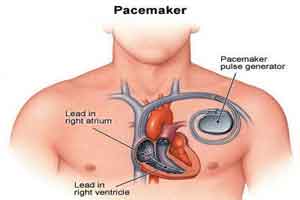- Home
- Editorial
- News
- Practice Guidelines
- Anesthesiology Guidelines
- Cancer Guidelines
- Cardiac Sciences Guidelines
- Critical Care Guidelines
- Dentistry Guidelines
- Dermatology Guidelines
- Diabetes and Endo Guidelines
- Diagnostics Guidelines
- ENT Guidelines
- Featured Practice Guidelines
- Gastroenterology Guidelines
- Geriatrics Guidelines
- Medicine Guidelines
- Nephrology Guidelines
- Neurosciences Guidelines
- Obs and Gynae Guidelines
- Ophthalmology Guidelines
- Orthopaedics Guidelines
- Paediatrics Guidelines
- Psychiatry Guidelines
- Pulmonology Guidelines
- Radiology Guidelines
- Surgery Guidelines
- Urology Guidelines
Premature Depletion of St Jude's pacemaker device : Indian Heart Rhythm Society guidelines for doctors

The incidences of premature battery depletion in the St Jude’s Implantable Cadioconverter-Defibrillator (ICD) and Cardiac Resynchronization Therapy Defibrillator (CRT-D) has created a stir among its users. Medical professionals, as well as patients, are deeply concerned about the cautious use of these pacemaker devices.
Following the reports of depletion, many advisories including the global medical device advisory by USFDA were announced. Recently, a guideline was published by the Indian Heart Rhythm Society (IHRS) in the Indian Heart Journal which explains the risk in the patients implanted with these devices and suggests possible mitigation strategies based on the recommendations by SJM, US FDA, and Indian Heart Rhythm Society (IHRS) advisory committee
The guideline article discussed the causes of premature battery depletion, a list of devices in which this problem was reported and the magnitude of the problem, and an estimate of the risk.
Below are the measures to mitigate risk due to premature battery depletion
Preparation and communication
- Doctors are suggested to make a list of patients with affected devices with the phone number, address, type of device and date of the implant.
- Patents who are known have expired or who have undergone cardiac transplant or device explantation due to infection or other reasons should be excluded from the list.
Out-patient follow up
- Doctors are advised to add “note” and check “Highlights at every follow up” (on the device)
- Interrogation should include battery longevity
- Assess pacing decency (ICD and CRT-D) and percentage pacing n ICDs
- Ensure Vibratory alert is “ON for ERI”
- Patients should be familiarized with the vibratory alert through demonstrations
- Assess present ICD indication in patients with primary prevention ICD indication.
- Doctors are advised to issue a request for a 3-months follow-up in those without remote monitoring
- Remote mentoring can be managed by the Merln.net for all/selected patients
- Prophylactic device replacement for highly selected patients should be considered
- IHRS should be notified if a patient with premature battery depletion with or without any adverse event is seen.
Recommendations for remote monitoring
- Patient residing at far-off locations and difficult to reach at an implanting center at short notice (Physicians decision or patient's preference or both)
- Patient not able to comprehend the vibratory alerts (Patient's decision)
- Pacing dependant patients with a high right ventricular threshold (around 2.5 V)
- Pacemaker dependent patients (physician decision/patient's preference)
- The patient recovered from ventricular tachycardia storm or appropriate ventricular fibrillation therapy in the last 3 months
Recommendations for Device replacement
- Evidence of battery depletion- ERI/Vibratory alert for battery depletion- as an emergency.
- Prophylactic device replacement ina pacing dependent patient if
- Has around 2.5 V right ventricular threshold
- is not willing for remote monitoring
- Can not/unwilling to follow-up every 3 months (for those without home monitoring)
- Physicians perceive risk-benefit in favor of replacement (many appropriate (ICD therapists)
- Patents desire and accept the risk of the replacement procedure
- Patients traveling abroad for an extended period of time with follow up being uncertain.
- Expected longevity of the device <1 year
To know about the guideline, please click on the link
http://dx.doi.org/10.1016/j.ihj.2016.12.014

Disclaimer: This site is primarily intended for healthcare professionals. Any content/information on this website does not replace the advice of medical and/or health professionals and should not be construed as medical/diagnostic advice/endorsement or prescription. Use of this site is subject to our terms of use, privacy policy, advertisement policy. © 2020 Minerva Medical Treatment Pvt Ltd